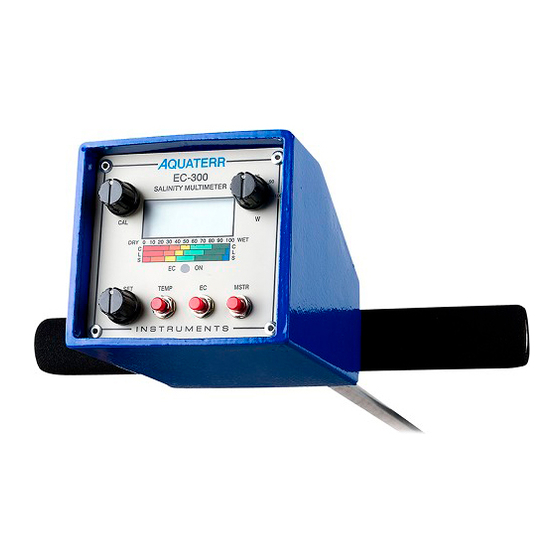AQUATERR INSTRUMENTS EC-300 Benutzerhandbuch - Seite 8
Blättern Sie online oder laden Sie pdf Benutzerhandbuch für Messgeräte AQUATERR INSTRUMENTS EC-300 herunter. AQUATERR INSTRUMENTS EC-300 11 Seiten.

It is important to remember that your Meter is a capacitance moisture meter. Capacitance
meters "look" at the air-water ratio in the soil. Thus, soil compaction has an affect on the
reading. A more compact soil will hold less air than a loose soil (like a sponge). This means
that the more compact soil will have higher readings than a loose soil. (See Guidebook for
further explanation). Also important is that your Meter is averaging the readings over the
entire sensor area. Thus, soil contact with the entire sensor is important.
When reading and interpreting the meter's color coding you should remember that the coding
is only meant to serve as a reference. It does not provide an optimal guide for all plants in all
soil types during all stages of growth.
• Blue: Free water is present.
• Dark Green: Ample soil moisture exists for virtually all plant growth.
• Light Green: Water level is approaching stress conditions. For young, budding and
drought sensitive plants irrigate in the upper one half of the zone. Use the lower
end of the zone for mature and drought resistant plants.
• Yellow: Stress is apt to occur, although most plants will survive if water condition is
temporary.
• Orange: Damaging stress to most plants.
• Red: Permanent wilting and death is likely.
While the color coding should only be used as a reference, it points out that plant stress not
only depends on plant type and stage of growth, but also depends on soil types. Thus, the "C",
"L" and "S" on the meter face indicate the reference color bands for Clay, Loam and Sandy
Loam, respectively.
EVALUATING THE SALINITY MEASUREMENTS (Salinity Multimeter)
Remember that you are taking a measurement of the salinity in the soil water. This is not the
same as finding the salinity of a solution extracted from the soil sample the way a lab does.
The difference is that the Salinity Multimeter measurements are evaluated at different soil
moisture levels. This means that:
• The measurement is what the roots are "seeing" now.
• Some salts, which do not dissolve as easily, might not be present in the soil water
which you are measuring.
• Salinity is more concentrated at lower moisture contents.
EVALUATING THE MOISTURE MEASUREMENTS
8
